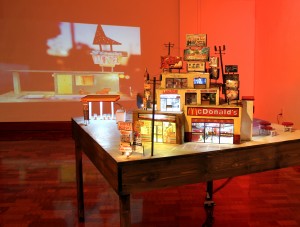Tracey Snelling: Another Day in Paradise
March 31 – August 19, 2012
Downtown Art Gallery, Bucknell University
In a small town, people fill their gas tanks beneath fluorescent lights, children sift through agates at the rock shop, and couples argue behind motel windows. The “small” town in question is 4 feet long by 4 feet wide; a scale-model of Anywhere USA created by Tracey Snelling. Snelling is a California-based artist whose miniature city-sculptures recall places in lovingly morbid detail, from the 99-cent hot dog promotion in the window of a 7-11 to the accumulated grime on the side of a 90-year old hotel. Everyone can experience the child-like joy of peering into these whimsical dioramas, but there is also more going on here.
In the 17th century, European explorers returned with plundered trophies for the nobles and wealthy businessmen who funded them – exotic plants, fossils, and artworks from afar. These collections were assembled in Cabinets of Wonder, the world-in-a-bottle, and eventually became the modern museums. The wives of these businessmen collectors, restricted to domestic concerns, commissioned sumptuous dollhouses that could cost as much as the real house they replicated and that showcased the owners’ wealth and good taste. Today, Snelling’s miniature worlds reiterate and mash up these parallel historic practices.
Snelling’s art applies the intimacy of the domestic gaze to the wide world outside. Her replicas of buildings and roads are not cold, fussy, perfect architectural models, but hand-made, almost sketchy personal impressions of a place. Though these places may not be specific, they always feel local, even when the local collides with the global, as in the work Stripmall (Los Angeles). Stripmall draws the viewer into tiny personal stories at the same time that it invokes larger narratives of urban sprawl and globalization.
Snelling’s work seems more socially aware than overtly political, and sometimes it veers in a different direction entirely. The work Last House on the Left imagines a seemingly average suburban street that is, in fact, home to four houses from American horror films: The Birds, Halloween, Nightmare on Elm Street, and the Amityville Horror. Gothic tales always involve an innocent and these films have the middle-class suburban home in that role. Horror is not relegated to an exotic distant castle, but it’s “in the house with you” as a cautious peek in these windows will demonstrate.
In the end, Snelling’s art breaks down the boundary between inside and outside: the global is local; the otherworldly is inside our house; and the museum has merged with the dollhouse. Right now, you are standing outside the worlds Tracey Snelling has made and inside the world she imagines.
Richard Rinehart,
Director

